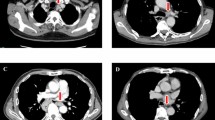Abstract
Background
The oncologic feasibility of video-assisted thoracoscopic (VATS) radical esophagectomy for esophageal cancer has yet to be proven. We evaluated the oncologic outcome of VATS-esophagectomy by reviewing our 10-year experience, with particular emphasis on the effect of lymph node dissection.
Methods
From January 2003 to December 2012, 146 patients with esophageal cancer underwent completion of VATS-esophagectomy in the left lateral position.
Results
The mean follow-up period was 37.1 months. Forty-six patients (31.5 %) had recurrence of cancer. Primary recurrence was hematogenous, lymphatic, peritoneal dissemination, pleural dissemination, locoregional, or port site in 20 (13.7 %), 23 (15.8 %), 2 (1.4 %), 5 (3.4 %), 4 (2.7 %), and 1 (0.67 %) patients, respectively. Pleural dissemination occurred more frequently after noncurative operation than curative operation (p = 0.010). The frequency of lymphatic metastasis within the mediastinal regional lymph nodes in the dissection field was only 5.5 %. The overall 5-year survival rate of stage I, II, and III disease after curative VATS-esophagectomy was 79.1, 77.9, and 56.7 %, respectively. T4 tumor, lymph node metastasis, R1 or 2, and concomitant lymph node metastasis in the cervical, mediastinal, and abdominal fields were indicators of unfavorable outcome. The lymph nodes in the abdominal region and those around the bilateral recurrent laryngeal nerves (RLNs) were frequent metastasis sites. Patients who had metastasis only around RLNs had favorable survival comparable to node-negative cases after curative VATS-esophagectomy.
Conclusions
Video-assisted thorascopic-esophagectomy has an excellent locoregional control effect with favorable oncologic outcome. The lymph node dissection procedure by VATS-esophagectomy has survival benefit for the patients having lymph node metastasis around bilateral RLNs.





Similar content being viewed by others
References
Akiyama H, Tsurumaru M, Udagawa H et al (1994) Radical lymph node dissection for cancer of the thoracic esophagus. Ann Surg 220:364–372 discussion 372–373
Fujita H, Kakegawa T, Yamana H et al (1995) Mortality and morbidity rates, postoperative course, quality of life, and prognosis after extended radical lymphadenectomy for esophageal cancer. Comparison of three-field lymphadenectomy with two-field lymphadenectomy. Ann Surg 222:654–662
Udagawa H, Ueno M, Shinohara H et al (2012) The importance of grouping of lymph node stations and rationale of three-field lymphoadenectomy for thoracic esophageal cancer. J Surg Oncol 106:742–747
Schoppmann SF, Prager G, Langer FB et al (2010) Open versus minimally invasive esophagectomy: a single-center case controlled study. Surg Endosc 24:3044–3053
Sundaram A, Geronimo JC, Willer BL et al (2012) Survival and quality of life after minimally invasive esophagectomy: a single-surgeon experience. Surg Endosc 26:168–176
Luketich JD, Pennathur A, Awais O et al (2012) Outcomes after minimally invasive esophagectomy: review of over 1,000 patients. Ann Surg 256:95–103
Nagpal K, Ahmed K, Vats A et al (2010) Is minimally invasive surgery beneficial in the management of esophageal cancer? A meta-analysis. Surg Endosc 24:1621–1629
Biere SS, van Berge Henegouwen MI, Maas KW et al (2012) Minimally invasive versus open oesophagectomy for patients with oesophageal cancer: a multicentre, open-label, randomised controlled trial. Lancet 379:1887–1892
Osugi H, Takemura M, Higashino M et al (2003) A comparison of video-assisted thoracoscopic oesophagectomy and radical lymph node dissection for squamous cell cancer of the oesophagus with open operation. Br J Surg 90:108–113
Shen Y, Zhang Y, Tan L et al (2012) Extensive mediastinal lymphadenectomy during minimally invasive esophagectomy: optimal results from a single center. J Gastrointest Surg 16:715–721
Kinjo Y, Kurita N, Nakamura F et al (2012) Effectiveness of combined thoracoscopic-laparoscopic esophagectomy: comparison of postoperative complications and midterm oncological outcomes in patients with esophageal cancer. Surg Endosc 26:381–390
Ninomiya I, Osugi H, Fujimura T et al (2008) Results of video-assisted thoracoscopic surgery for esophageal cancer during the induction period. Gen Thorac Cardiovasc Surg 56:119–125
Ninomiya I, Osugi H, Tomizawa N et al (2010) Learning of thoracoscopic radical esophagectomy: how can the learning curve be made short and flat? Dis Esophagus 23:618–626
Osugi H, Takemura M, Higashino M et al (2002) Video-assisted thoracoscopic esophagectomy and radical lymph node dissection for esophageal cancer. A series of 75 cases. Surg Endosc 16:1588–1593
Ozawa S, Tachimori Y, Baba H et al (2011) Comprehensive registry of esophageal cancer in Japan, 2003. Esophagus 8:9–29
Ando N, Kato H, Igaki H et al (2012) A randomized trial comparing postoperative adjuvant chemotherapy with cisplatin and 5-fluorouracil versus preoperative chemotherapy for localized advanced squamous cell carcinoma of the thoracic esophagus (JCOG9907). Ann Surg Oncol 19:68–74
Kosugi S, Ichikawa H, Kanda T et al (2012) Clinicopathological characteristics and prognosis of patients with esophageal carcinoma invading adjacent structures found during esophagectomy. J Surg Oncol 105:767–772
Ohtsu A, Boku N, Muro K et al (1999) Definitive chemoradiotherapy for T4 and/or M1 lymph node squamous cell carcinoma of the esophagus. J Clin Oncol 17:2915–2921
Osugi H, Takemura M, Takada N et al (2002) Prognostic factors after oesophagectomy and extended lymphadenectomy for squamous oesophageal cancer. Br J Surg 89:909–913
Bakhos CT, Fabian T, Oyasiji TO et al (2012) Impact of the surgical technique on pulmonary morbidity after esophagectomy. Ann Thorac Surg 93:221–226 discussion 226–227
Osugi H, Takemura M, Higashino M et al (2003) Learning curve of video-assisted thoracoscopic esophagectomy and extensive lymphadenectomy for squamous cell cancer of the thoracic esophagus and results. Surg Endosc 17:515–519
Noshiro H, Nagai E, Shimizu S et al (2007) Minimally invasive radical esophagectomy for esophageal cancer. Esophagus 4:59–65
Ben-David K, Sarosi GA, Cendan JC et al (2012) Decreasing morbidity and mortality in 100 consecutive minimally invasive esophagectomies. Surg Endosc 26:162–167
Palanivelu C, Prakash A, Senthilkumar R et al (2006) Minimally invasive esophagectomy: thoracoscopic mobilization of the esophagus and mediastinal lymphadenectomy in prone position—experience of 130 patients. J Am Coll Surg 203:7–16
Author information
Authors and Affiliations
Corresponding author
Additional information
This study was orally presented at an ISW 2013 as Grassi Prize Presentation.
Rights and permissions
About this article
Cite this article
Ninomiya, I., Okamoto, K., Fujimura, T. et al. Oncologic Outcomes of Thoracoscopic Esophagectomy with Extended Lymph Node Dissection: 10-year Experience from a Single Center. World J Surg 38, 120–130 (2014). https://doi.org/10.1007/s00268-013-2238-8
Published:
Issue Date:
DOI: https://doi.org/10.1007/s00268-013-2238-8




